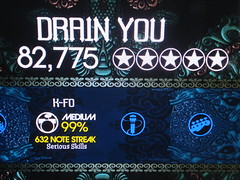Understanding Your PSAT Score Report
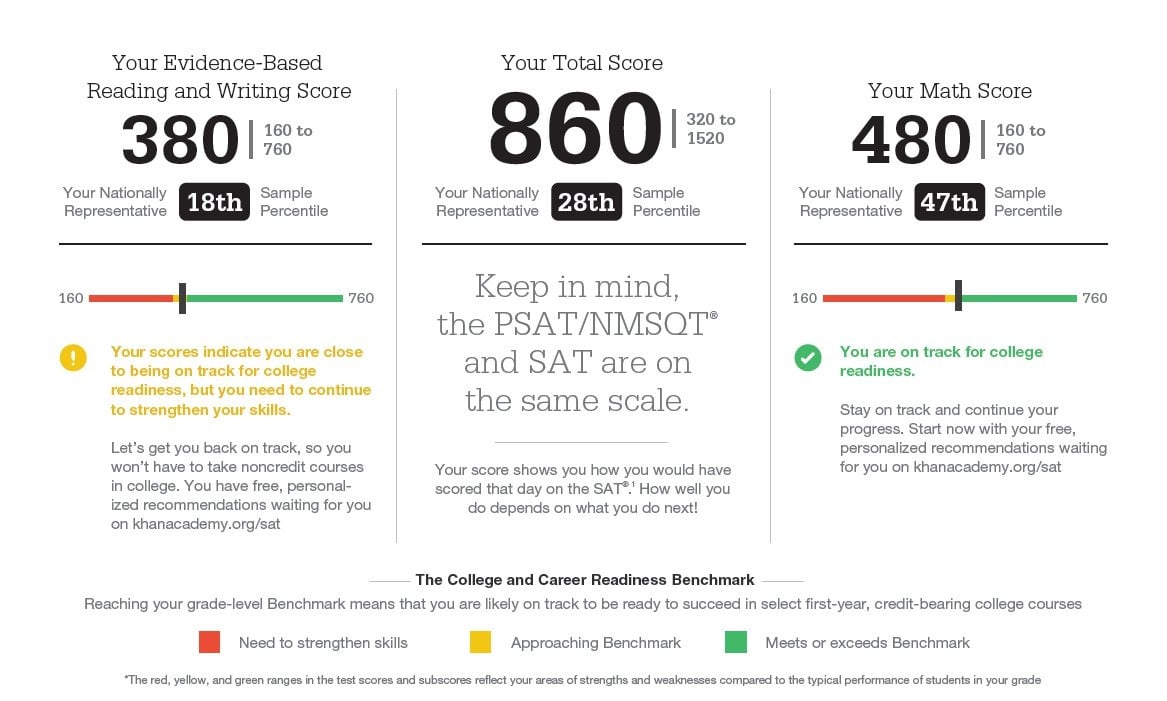
So you have your PSAT score report, but you’re not sure what all of the different numbers and colors mean; don’t worry, because we’re here to help. Below, you will find answers to common questions about the PSAT score report.
For this post, we’re going to use the sample PSAT score report provided by the College Board. Please contact us if you have any questions about your own PSAT score report.
Why there are three scores on the top of the score report and what do they mean?
On the top of your score report, you will see three distinct scores: the Evidence-Based Reading and Writing Score, the Math Score, and the Total Score.
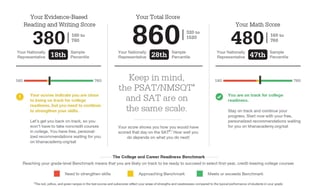 Your Evidence-Based Reading and Writing Score will be a three-digit number from 160 to 760, 760 being the highest. In the sample report, you can see that the score is a 380, which represents the 18th percentile: this means that this student’s score was greater than or equal to the scores of 18 percent of the same-grade-level students who took the PSAT. Another way to understand percentiles is to imagine the following: if 100 students took the test, the 18th percentile would mean that this student scored just as well as or better than 18 students and just as well as or worse than 82 of the 100 students. On the PSAT (and SAT), a higher three-digit score will result in a higher percentile. You can look at the sample math score for an example of this correlation.
Your Evidence-Based Reading and Writing Score will be a three-digit number from 160 to 760, 760 being the highest. In the sample report, you can see that the score is a 380, which represents the 18th percentile: this means that this student’s score was greater than or equal to the scores of 18 percent of the same-grade-level students who took the PSAT. Another way to understand percentiles is to imagine the following: if 100 students took the test, the 18th percentile would mean that this student scored just as well as or better than 18 students and just as well as or worse than 82 of the 100 students. On the PSAT (and SAT), a higher three-digit score will result in a higher percentile. You can look at the sample math score for an example of this correlation.
Directly under the score, you will see a colored line that is red on the left, yellow in the middle, and green on the right. There is also a black tick mark that shows where the score falls on the line. In the sample report, you will see this mark at the 380 point, which happens to be in the yellow section of the line. You will also see notes about the score in this section. In general, the three different colors mean the following:
Green – indicates strength and that the score meets or exceeds the benchmark for that section.
Yellow – indicates the score is close to the benchmark level but that the skills necessary for meeting the benchmark in that section require some work.
Red – indicates weakness and the need to strengthen skills in order to meet the benchmark.
You may be asking yourself: how did they come up with the three-digit number (in this case a 380) for this score? To understand this, you need to look at the Test Scores section below. To come up with the 380, you will add the 18 for Reading and the 20 for Writing and Language to make a total of 38. Now multiply the 38 by 10 and you’ll get 380.
What about my Math Score? Your math score is also presented as a three-digit number from 160 to 760, 760 being the best. In the sample report, you can see the math score is a 480, which places this student in the 47th percentile. Remember this means that this student’s score was equal to or higher than the scores of 47 percent of the same-grade-level students on the math section.
Under the math score you will find the red, yellow, and green line with the math section score indicated along with notes about the score on the math section. In this sample report, you can see that a 480 puts the student in the green section, which means this student is meeting or exceeding the benchmark.
The calculation of the math section’s three-digit score is done a bit differently. Just as with the Reading and Writing score, you must go below to the Test Scores section, but this time, you must multiply the total math score by 20. In the sample score report, the math test score is a 24, which equals 480 when multiplied by 20.
Ok, now I understand my Reading and Writing Score. What about My Total Score? Determining the total score is as simple as adding the Reading and Writing Score and Math Score together. In this case, the total is 860 which is 380 Reading and Writing + 480 Math. Just as with the two other scores, a total score percentile shows how this score compares with that of other test takers. A higher percentile is better.
A special note: because the total score is simply the sum of the Evidence-Based Reading & Writing and Math scores, the math score accounts for half of the total score even though there are three test scores listed (Reading, Writing and Language, and Math).
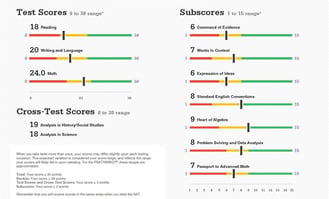 What about the Subscores? Reading, Writing and Language, and Math each have subscores that are scored from 1 to 15, 15 being the top score. The subscores will be shown on the now-familiar red, yellow, and green number line. The same color code is used here as above.
What about the Subscores? Reading, Writing and Language, and Math each have subscores that are scored from 1 to 15, 15 being the top score. The subscores will be shown on the now-familiar red, yellow, and green number line. The same color code is used here as above.
Reading Subscores = Command of Evidence and Words in Context
Writing and Language Subscores = Expression of Ideas and Standard English Conventions
Math Subscores = Heart of Algebra, Problem Solving, and Passport to Advanced Math
We’ll get more into these subscore sections in future blog posts.
What are the Cross-Test Scores? Under the Test Scores section you will see two cross-test sections–– Analysis in History/Social Studies and Analysis of Science.––along with a score for each, 38 being the top score. On the sample score report you can see a score of 18 for Analysis of Science.
From the College Board: “These scores are based on questions in the Reading, Writing and Language, and Math Tests that ask students to think analytically about texts and problems in these subject areas.”
This means that, throughout the test, there are questions that are tagged as Analysis in History/Social Studies and Analysis of Science questions. Your score for these sections is determined by how you answered these questions. When you look at the Your Question-Level Feedback section you will see which questions were tagged as Analysis in History/Social Studies and Analysis of Science questions.
What is the National Merit Scholarship section and why do I have a NMSC Selection Index score? The PSAT is not only a practice run for the SAT, but is also the qualifying test for the National Merit Scholarship. Additional information about the National Merit Scholarship can be found at www.nationalmerit.org; you can also read eligibility information on your score report. For the sake of time let’s just look at the number.
 On the sample score report you can see a score of 124. This score is calculated by adding the three test score sections together 18 Reading + 20 Writing and Language + 24 Math = 62 and multiplying that number by 2. So 62 x 2 = 124.
On the sample score report you can see a score of 124. This score is calculated by adding the three test score sections together 18 Reading + 20 Writing and Language + 24 Math = 62 and multiplying that number by 2. So 62 x 2 = 124.
If you see a * next to the index score, this means you do not meet the entry requirements for National Merit Scholarship selection. Usually, this applies to students who take the PSAT before their junior years.
Sometime in September, the qualifying cutoff scores are released. The qualifying scores vary by state. Because this is the first administration of a new test, the cutoff scores are speculative for now. It is likely that the cutoff scores will be greater than 195 for most states; the cutoff in many states will be over 200.
How about the “Your Scores: Next Steps” section? This section of the score report is pretty self-explanatory. Here, you will see skills in which you are already proficient as well as skills that need improving.
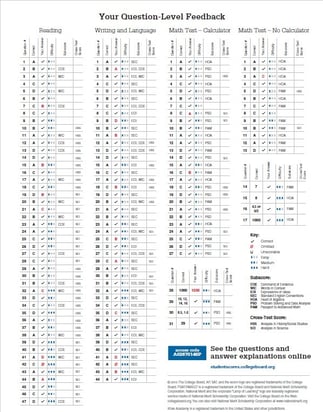 It looks like the last page of the report shows my answer choices. Is this correct? Yes: the last page of the score report is called “Your Question-Level Feedback”, which is a fancy way of citing your answer choices to each question.
It looks like the last page of the report shows my answer choices. Is this correct? Yes: the last page of the score report is called “Your Question-Level Feedback”, which is a fancy way of citing your answer choices to each question.
This section has potential to be the most important section of the score report because it shows you exactly which questions you answered correctly and incorrectly. To view the actual questions, you must have your test booklet or log on to the College Board’s website. It is a smart idea to at least look at the questions that you answered incorrectly so that you can see if you made a simple mistake or if you need to improve your knowledge in that area.
You will also notice the key that shows the question type by subscore and cross-test score.
Do you have more questions about your PSAT score report? Contact us here or leave a comment.


